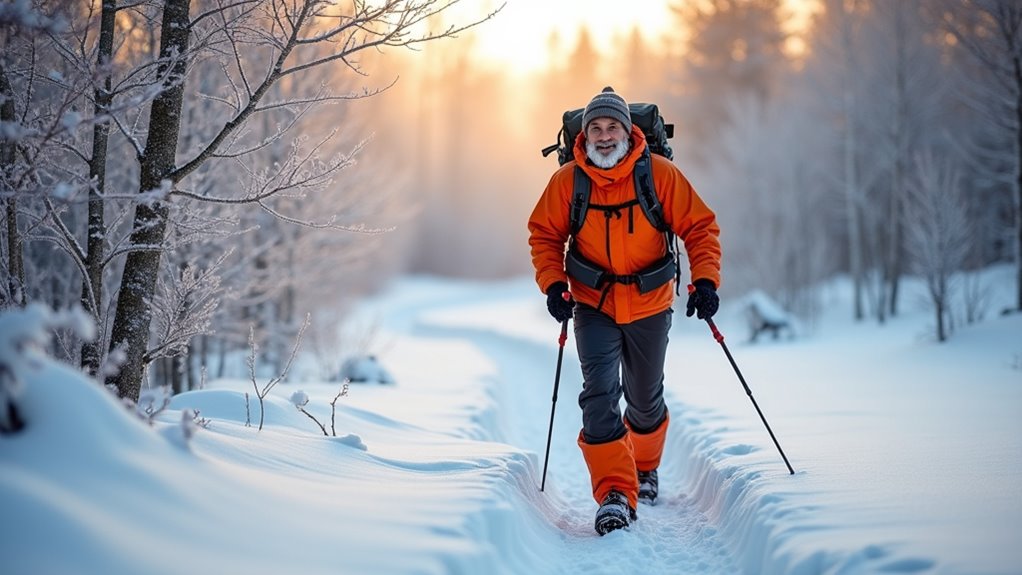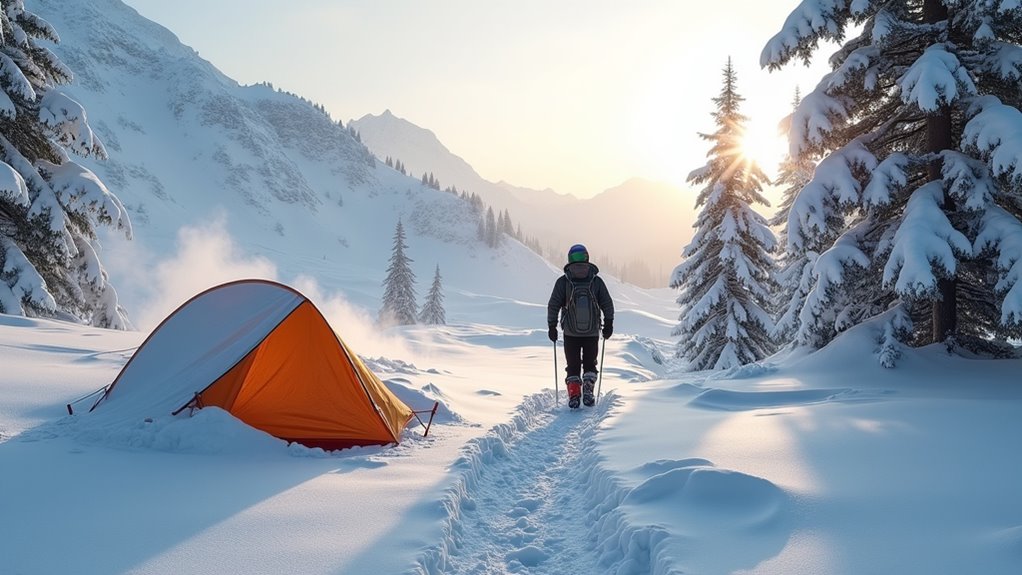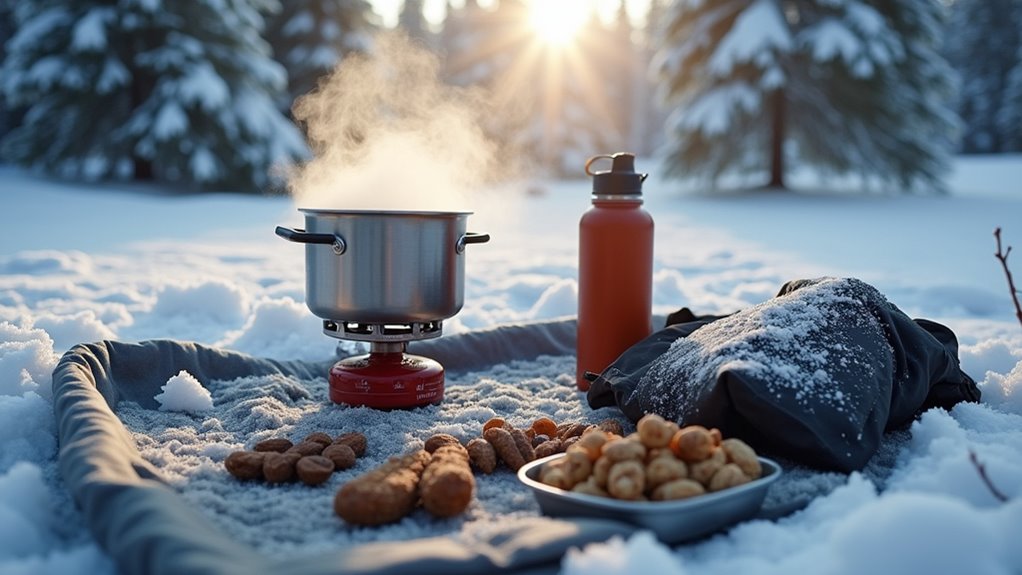Physical Address
304 North Cardinal St.
Dorchester Center, MA 02124
Physical Address
304 North Cardinal St.
Dorchester Center, MA 02124

Outdoor winter backpacking requires specialized gear and survival techniques that most hikers don't know—discover the essential secrets before your first cold-weather adventure.
When you’re planning your first winter backpacking trip, you’ll quickly discover that summer gear won’t cut it in freezing temperatures. The margin for error shrinks dramatically when snow starts falling and temperatures drop below freezing. You can’t simply throw on extra layers and hope for the best – winter backpacking demands specific gear choices, proven techniques, and careful preparation that could mean the difference between an epic adventure and a dangerous situation.

When temperatures drop and snow blankets the trails, your gear selection becomes the difference between a memorable adventure and a potentially dangerous situation. You’ll need a four-season tent that handles wind and snow loads, plus a sleeping bag rated 10-15 degrees below expected temperatures. Don’t skimp on insulation – pack extra layers you can remove as needed.
Your backpack should accommodate bulkier winter gear, so size up from your summer pack. Waterproof boots with good traction are non-negotiable, and microspikes or snowshoes depend on terrain conditions. Bring a reliable headlamp with extra batteries since they drain faster in cold weather.
Emergency items like a whistle, first-aid kit, and fire starter aren’t optional – they’re lifesavers when winter conditions turn harsh. When selecting your winter camping gear, prioritize low impact options that minimize your environmental footprint on fragile winter ecosystems.
Having the right gear means nothing if you haven’t mapped out a safe winter route that matches your skill level. Start with familiar trails you’ve hiked in warmer months – winter transforms terrain dramatically. Check recent trail reports, weather forecasts, and avalanche conditions before leaving.
Winter transforms familiar trails into entirely different terrain, making route planning as crucial as having the right equipment for safe hiking.
Plan shorter distances than summer hikes since snow slows progress considerably.
Always file a detailed trip plan with someone reliable, including your route, timeline, and emergency contacts. Choose trails with multiple exit points and avoid exposed ridges during storms.
Study topographic maps for potential hazards like creek crossings that might be dangerous when frozen.
Pack extra food and fuel – you’ll burn more calories staying warm. Most importantly, don’t hesitate to turn back if conditions deteriorate beyond your experience level.
Before heading out, ensure your gear has been properly maintained after previous trips and that you know how to store camping gear effectively between winter adventures to maintain its performance and longevity.

While proper gear forms your foundation, managing body heat effectively determines whether you’ll stay comfortable or face dangerous hypothermia on winter trails. Your body’s core temperature matters most—keep your torso warm, and blood will circulate to your extremities naturally.
Layer strategically using the three-layer system: moisture-wicking base layer, insulating middle layer, and waterproof outer shell. Add or remove layers before you overheat or get too cold. Sweating kills warmth faster than anything.
Eat high-calorie foods regularly—your body needs fuel to generate heat. Keep snacks accessible in inside pockets where they won’t freeze. Drink warm liquids frequently, but avoid alcohol and caffeine, which reduce circulation.
Move consistently to maintain circulation, but don’t exhaust yourself. If extremities get cold, swing your arms vigorously or do jumping jacks.
These heat management principles apply whether you’re on a day hike or setting up family camping for multiple nights in winter conditions.
Since winter camping demands more from your shelter than fair-weather trips, you’ll need to master techniques that work with snow rather than against it. Pack down your campsite by stomping or using snowshoes to create a firm platform. This prevents you from sinking into soft snow overnight.
Pitch your tent’s footprint first, then shake off snow before setting up the fly. Angle your entrance away from prevailing winds and pile snow around the tent’s base for insulation and stability. Don’t zip the fly completely—you need ventilation to prevent dangerous condensation buildup.
Clear snow from above before it accumulates on your shelter. A collapsing tent in freezing temperatures isn’t just inconvenient—it’s potentially life-threatening. Keep your shovel accessible for midnight snow removal duties.
For extended winter adventures, consider transitioning to caravan camping once you reach accessible areas, as this provides superior warmth and comfort during harsh weather conditions.

Your body burns 300-500 extra calories per day in cold conditions, so you’ll need to pack considerably more food than summer trips require. Focus on calorie-dense options like nuts, dried fruits, energy bars, and pasta. Hot meals boost morale and warm you from inside—instant oatmeal, soup mixes, and dehydrated meals work well.
Water management becomes tricky below freezing. Keep bottles inside your sleeping bag overnight to prevent freezing. Consider insulated bottle sleeves or wide-mouth containers that won’t crack when frozen. Melting snow requires extra fuel, so budget accordingly.
Pack extra snacks for quick energy boosts throughout the day. Your appetite might decrease in extreme cold, but consistent eating maintains body heat and energy levels essential for safe winter travel. While these winter nutrition strategies differ significantly from summer approaches, remember that safe camping practices remain important year-round regardless of the season.
You’ve armed yourself with the knowledge to conquer winter’s icy grip without breaking the bank. Remember, you don’t need gold-plated gear—just smart choices and solid preparation. When you’re out there with snowflakes dancing around your headlamp and your breath creating tiny clouds, you’ll feel like you’ve revealed nature’s secret winter kingdom. Trust your planning, respect the cold’s power, and you’ll return home with memories that’ll warm you for years.